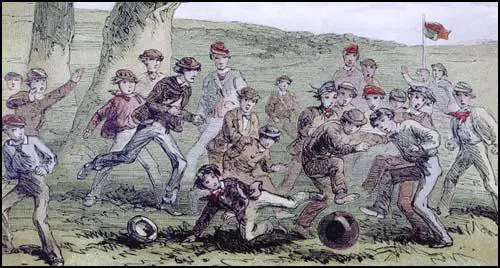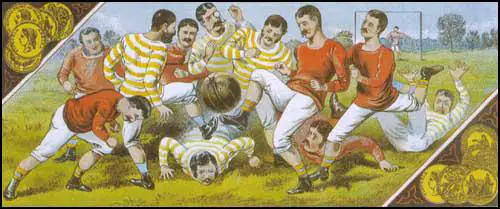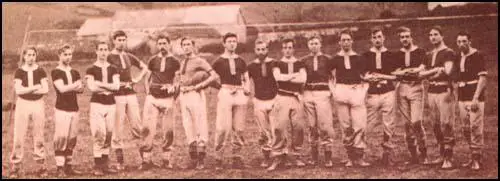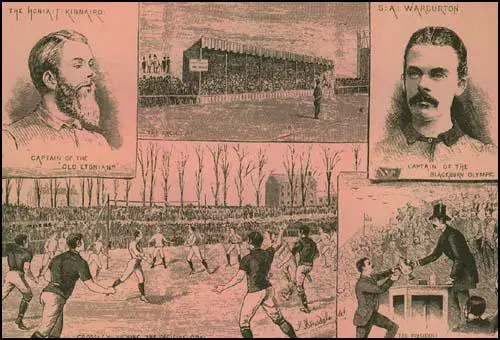Football in Public Schools
In the 18th century football was played by most of Britain's leading public schools. There is documentary evidence that football was played at Eton as early as 1747. Westminster started two years later. Harrow, Shrewsbury, Winchester and Charterhouse had all taken up football by the 1750s.
English public schools played an important role in the development of the modern game of football. Football rules began to be codified in schools such as Eton (1815) and Aldenham (1825). Other schools such as Rugby, Marlborough, Lancing, Uppingham, Malvern and Cheltenham also introduced football to the school curriculum.

Thomas Arnold was appointed headmaster of Rugby in 1828. He had a profound and lasting effect on the development of public school education in England. Arnold introduced mathematics, modern history and modern languages and instituted the form system and introduced the prefect system to keep discipline. He modernized the teaching of Classics by directing attention to literary, moral or historical questions. Although Arnold held strong views, he made it clear to his students they were not expected to accept those views, but to examine the evidence and to think for themselves.
Arnold also emphasized the importance of sport in young men's education. Like most headteachers in public schools, Arnold believed that sport was a good method for "encouraging senior boys to exercise responsible authority on behalf of the staff". He also argued that games like football provided a "formidable vehicle for character building".

Each school had its own set of rules and style of game. In some schools the ball could be caught, if kicked below the hand or knee. If the ball was caught near the opposing goal, the catcher had the opportunity of scoring, by carrying it through the goal in three standing jumps.
Rugby, Marlborough and Cheltenham developed games that used both hands and feet. The football played at Shrewsbury and Winchester placed an emphasis on kicking and running with the ball (dribbling). School facilities also influenced the rules of these games. Students at Charterhouse played football within the cloisters of the old Carthusian monastery. As space was limited the players depended on dribbling skills. Whereas schools like Eton and Harrow had such large playing fields available that they developed a game that involved kicking the ball long distances.
According to one student at Westminster, the football played at his school was a very rough game: "When running... the enemy tripped, shinned, charged with the shoulder, got down and sat upon you... in fact did anything short of murder to get the ball from you."
In 1848 a meeting took place at Cambridge University to lay down the rules of football. As Philip Gibbons points out in Association Football in Victorian England (2001): "The varying rules of the game meant that the public schools were unable to compete against each other." Teachers representing Shrewsbury, Eton, Harrow, Rugby, Marlborough and Westminster, produced what became known as the Cambridge Rules. One participant explained what happened: "I cleared the tables and provided pens and paper... Every man brought a copy of his school rules, or knew them by heart, and our progress in framing new rules was slow."
It was eventually decided that goals would be awarded for balls kicked between the flag posts (uprights) and under the string (crossbar). All players were allowed to catch the ball direct from the foot, provided the catcher kicked it immediately. However, they were forbidden to catch the ball and run with it. Only the goalkeeper was allowed to hold the ball. He could also punch it from anywhere in his own half. Goal kicks and throw-ins took place when the ball went out of play. It was specified that throw-ins were taken with one hand only. It was also decided that players in the same team should wear the same colour cap (red and dark blue).
Sometimes public schools played football against boys from the local town. Although these games often ended in fights, it did help to spread knowledge of Cambridge Rules football. Former public school boys also played football at university. Many continued to play after finishing their education. Some joined clubs like the Old Etonians, Old Harrovians and the Wanderers (a side only open to men who had attended the leading public schools), whereas others formed their own clubs. For example, former pupils of the Sheffield Collegiate School established the Sheffield Football Club at Bramall Lane. In 1857 they published their own set of rules for football. These new rules allowed for more physical contact than those established in Cambridge. Players were allowed to push opponents off the ball with their hands. It was also within the rules to shoulder charge players, with or without the ball. If a goalkeeper caught the ball, he could be barged over the line.
In 1862 a new set of rules were established at Cambridge University. These specified 11-a-side, an umpire from each side plus a neutral referee, goals 12ft across and up to 20ft high. An offside rule was added. A man could play a ball passed to him from behind, so long as there were three opponents between him and the goal. It was also decided that each game should only last one hour and a quarter. The first game under these rules took place between the Old Etonians and Old Harrovians in November, 1862.

Some public schools refused to accept the Cambridge Rules. At Uppingham School in Rutland, the students played with an enormously wide goal. In 1862, one of the teachers at Uppingham, John Charles Thring, published his own set of rules:
1. A goal is scored whenever the ball is forced through the goal and under the bar, except it be thrown by hand.
2. Hands may be used only to stop a ball and place it on the ground before the feet.
3. Kicks must be aimed only at the ball.
4. A player may not kick the ball whilst in the air.
5. No tripping up or heel kicking allowed.
6. Whenever a ball is kicked beyond the side flags, it must be returned by the player who kicked it, from the spot it passed the flag line, in a straight line towards the middle of the ground.
7. When a ball is kicked behind the line of goal, it shall be kicked off from that line by one of the side whose goal it is.
8. No player may stand within six paces of the kicker when he is kicking off.
9. A player is ‘out of play’ immediately he is in front of the ball and must return behind the ball as soon as possible. If the ball is kicked by his own side past a player, he may not touch or kick it, or advance, until one of the other side has first kicked it, or one of his own side has been able to kick it on a level with, or in front of him.
10. No charging allowed when a player is ‘out of play’; that is, immediately the ball is behind him.
Thring published his rules under the title, The Simplest Game. Some teachers liked this non-violent approach and several schools adopted Thring's rules.
The Football Association was established in October, 1863. The aim of the FA was to establish a single unifying code for football. The first meeting took place at the Freeman's Tavern in London. The clubs represented at the meeting included Barnes, Blackheath, Perceval House, Kensington School, the War Office, Crystal Palace, Epping Forest, the Crusaders and No Names of Kilburn. Charterhouse also sent an observer to the meeting.
Ebenezer Cobb Morley was elected as the secretary of the FA. At a meeting on 24th November, 1863, Morley presented a draft set of 23 rules. These were based on an amalgamation of rules played by public schools, universities and football clubs. This included provision for running with the ball in the hands if a catch had been taken "on the full" or on the first bounce. Players were allowed to "hack the front of the leg" of the opponent when they were running with the ball. Two of the proposed rules caused heated debate:
IX. A player shall be entitled to run with the ball towards his adversaries' goal if he makes a fair catch, or catches the ball on the first bound; but in case of a fair catch, if he makes his mark (to take a free kick) he shall not run.
X. If any player shall run with the ball towards his adversaries' goal, any player on the opposite side shall be at liberty to charge, hold, trip or hack him, or to wrest the ball from him, but no player shall be held and hacked at the same time.
Some members objected to these two rules as they considered them to be "uncivilised". Others believed that charging, hacking and tripping were important ingredients of the game. One supporter of hacking argued that without it "you will do away with the courage and pluck of the game, and it will be bound to bring over a lot of Frenchmen who would beat you with a week's practice." The main defender of hacking was F. W. Campbell, the representative from Blackheath, who considered this aspect of the game was vital in developing "masculine toughness". Campbell added that "hacking is the true football" and he resigned from the FA when the vote went against him (13-4). He later helped to form the rival Rugby Football Union. On 8th December, 1863, the FA published the Laws of Football.
1. The maximum length of the ground shall be 200 yards, the maximum breadth shall be 100 yards, the length and breadth shall be marked off with flags; and the goal shall be defined by two upright posts, eight yards apart, without any tape or bar across them.
2. A toss for goals shall take place, and the game shall be commenced by a place kick from the centre of the ground by the side losing the toss for goals; the other side shall not approach within 10 yards of the ball until it is kicked off.
3. After a goal is won, the losing side shall be entitled to kick off, and the two sides shall change goals after each goal is won.
4. A goal shall be won when the ball passes between the goal-posts or over the space between the goal-posts (at whatever height), not being thrown, knocked on, or carried.
5. When the ball is in touch, the first player who touches it shall throw it from the point on the boundary line where it left the ground in a direction at right angles with the boundary line, and the ball shall not be in play until it has touched the ground.
6. When a player has kicked the ball, any one of the same side who is nearer to the opponent's goal line is out of play, and may not touch the ball himself, nor in any way whatever prevent any other player from doing so, until he is in play; but no player is out of play when the ball is kicked off from behind the goal line.
7. In case the ball goes behind the goal line, if a player on the side to whom the goal belongs first touches the ball, one of his side shall he entitled to a free kick from the goal line at the point opposite the place where the ball shall be touched. If a player of the opposite side first touches the ball, one of his side shall be entitled to a free kick at the goal only from a point 15 yards outside the goal line, opposite the place where the ball is touched, the opposing side standing within their goal line until he has had his kick.
8. If a player makes a fair catch, he shall be entitled to a free kick, providing he claims it by making a mark with his heel at once; and in order to take such kick he may go back as far as he pleases, and no player on the opposite side shall advance beyond his mark until he has kicked.
9. No player shall run with the ball.
10. Neither tripping nor hacking shall be allowed, and no player shall use his hands to hold or push his adversary.
11. A player shall not be allowed to throw the ball or pass it to another with his hands.
12. No player shall be allowed to take the ball from the ground with his hands under any pretence whatever while it is in play.
13. No player shall be allowed to wear projecting nails, iron plates, or gutta-percha on the soles or heels of his boots.
English public schools also provided most of the players who appeared in the national team. For example, Westminster supplied ten England internationals between 1873 and 1894, whereas Old Etonians won a total of 39 England caps between 1873 and 1903.
The public schools also provided most of the early administrators, including , Arthur Kinnaird, Charles Wreford Brown and Francis Marindin.
In 1871, Charles W. Alcock, the FA Secretary, announced the introduction of the Football Association Challenge Cup. It was the first knockout competition of its type in the world. Only 15 clubs took part in the first staging of the tournament. It included two clubs based in Scotland, Donington School and Queen's Park. In the 1872 final, the public school team Wanderers beat the Royal Engineers 1-0 at the Kennington Oval.
The Wanderers, based in Battersea in London, went onto win the FA Cup five times in its first seven seasons, between 1872 and 1878. Old Etonians won the cup in 1879 and 1882. Old Carthusians, a team made up of former students at Charterhouse, defeated the Old Etonians in the 1881 final 3-0.

In 1885 it was decided by the Football Association that clubs could play professionals in the FA Cup competition. This marked the end of the public school dominance of the competition.
